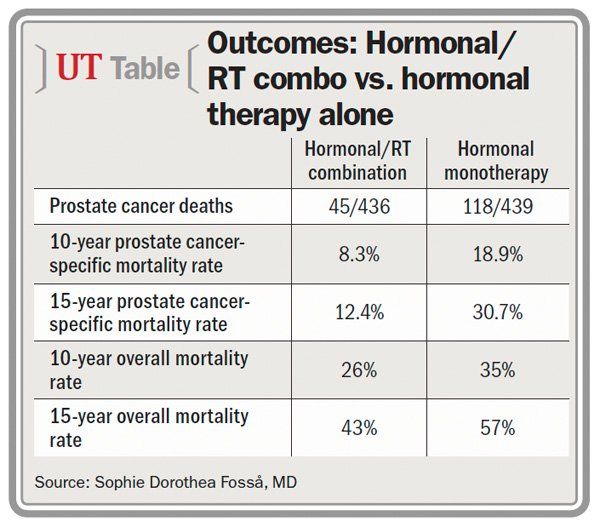Article
RT, hormonal combo treatment reduces prostate cancer mortality
Author(s):
Adding local radiotherapy to hormonal treatment more than halves long-term prostate cancer-specific mortality and substantially decreases overall mortality in men with non-metastatic locally advanced or high-risk prostate cancer, according to an updated analysis of clinical trial data from the Scandinavian Prostate Cancer Group’s Study VII.
San Francisco-Adding local radiotherapy to hormonal treatment more than halves long-term prostate cancer-specific mortality and substantially decreases overall mortality in men with non-metastatic locally advanced or high-risk prostate cancer, according to an updated analysis of clinical trial data from the Scandinavian Prostate Cancer Group’s Study VII.
Compared with anti-androgens alone, the combination treatment “more than doubles the 10-year survival rate and confirms that this approach should be a standard option for men with this type of prostate cancer who are expected to live at least another 10 years,” said lead author Sophie Dorothea Fosså, MD, who presented the data at the Genitourinary Cancers Symposium in San Francisco.
“In 1996, lifelong castration treatment was the standard treatment in patients with locally advanced (or so-called high-risk) prostate cancer without metastases. Most of these patients were at that time viewed as inoperable. At the same time, we had data that showed that oral anti-androgens resulted in fewer side effects than castration treatment without having a negative impact on survival,” said Dr. Fosså, professor of oncology at Oslo University Hospital in Oslo, Norway.

Continue to next page for more.
The study included 875 patients with locally advanced prostate cancer who received 3 months of total androgen blockade and then were randomized to continuous anti-androgen therapy or continuous anti-androgens plus radiotherapy (70-74 Gy). They were followed for a median of 10.7 years.
After nearly 8 years of observation, results published in 2009 showed a 12% reduction in prostate cancer-specific mortality in the patients randomized to radiotherapy and continuous hormone therapy compared with those randomized to hormone therapy alone.
In the updated analysis presented here, observation was extended to 11 years. Among the 439 men who received hormone therapy alone, 118 died of prostate cancer, compared with 45 of 436 men who received radiotherapy in addition to hormone therapy. The 10-year prostate cancer-specific mortality rate was 8.3% among men receiving the combination compared with 18.9% among men receiving hormone therapy alone, a 65% relative reduction with the addition of radiotherapy. The 15-year prostate cancer-specific mortality rates in the two groups were 12.4% and 30.7%, respectively.
High dosage may explain benefit
Dr. Fosså noted that the radiation dose used in the study is higher than is typically used in the United States, which may help explain the benefit observed to radiotherapy.
The overall mortality rate at 10 years was 26% in the combination arm compared with 35% in the hormone therapy-only arm, and at 15 years, the rates were 43% and 57%, respectively.
“The [reduction in] overall mortality is less because many of these patients die from other diseases than prostate cancer. But even here you see that overall mortality is reduced compared to hormone treatment alone,” Dr. Fosså said.
The 10-year prostate cancer-specific mortality rate of 8% is comparable to results after prostatectomy in comparable patients.
“This combination of radiotherapy and hormones may be considered as a standard curative treatment option in these patients. It is more or less comparable to modern prostatectomy,” Dr. Fosså said.UT
Like this article? Check out these other recent Urology Times articles:
Dose-escalated IMRT appears safe in prostate cancer patients
PDE-5 inhibitor fails to prevent ED after radiation
Primary ADT for prostate cancer shows no survival benefit
Subscribe to Urology Times to get monthly news from the leading news source for urologists.















